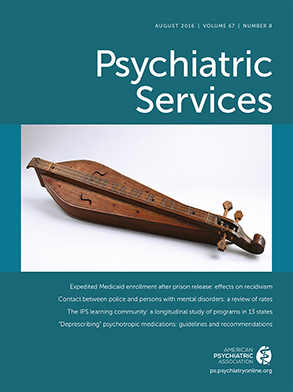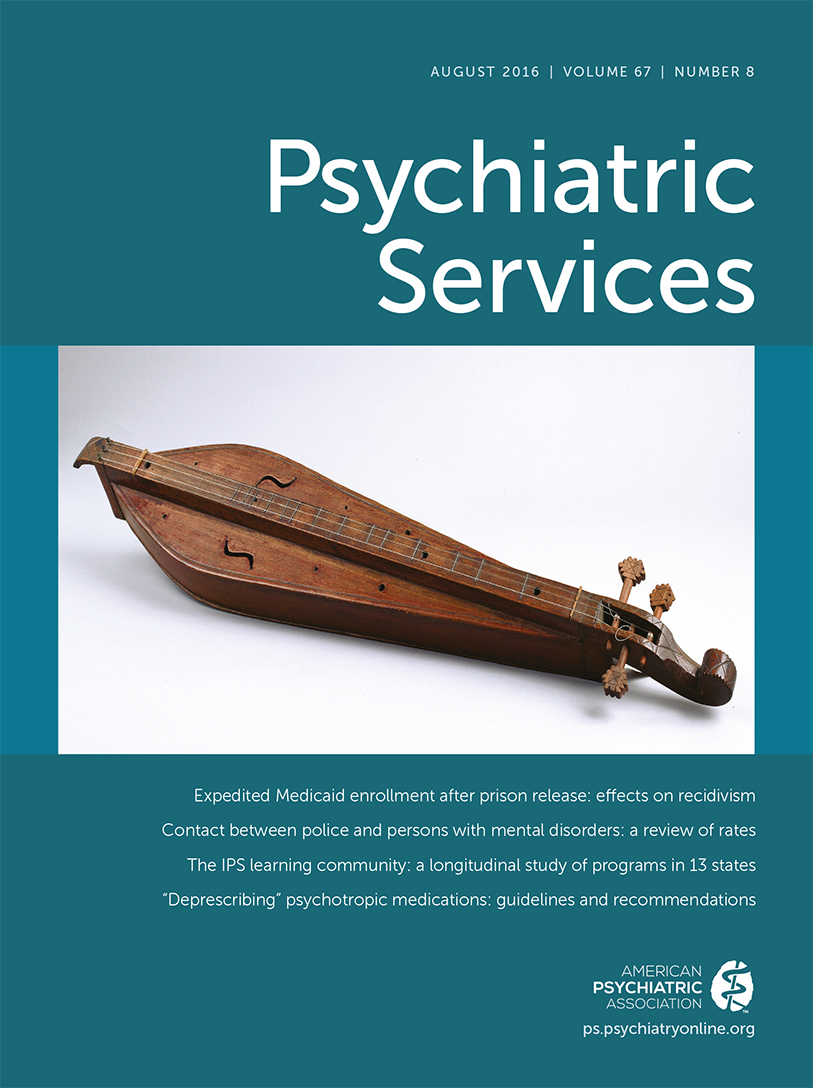Studies have linked combat duty in Operation Iraqi Freedom and Operation Enduring Freedom with the development of postdeployment health problems, particularly posttraumatic stress disorder (PTSD). In studies involving soldiers in infantry units that engaged in combat, an average of 13% met criteria for PTSD, with higher prevalence rates in some units depending on the level of combat exposure (
1,
2). However, among soldiers who experience PTSD symptoms postdeployment, only about half are estimated to receive mental health care (
3).
Furthermore, researchers have speculated that the PTSD diagnostic code (
ICD-9 309.81) might not be recorded in the electronic health record (EHR) for soldiers who receive treatment for PTSD in military treatment facilities (
4). For example, some service members who receive treatment may fear that the diagnosis will harm their careers or lead to a medical discharge. Soldiers may not want the diagnosis to be visible to medics and primary care doctors embedded in their units who have access to their EHR. In addition, military clinicians are encouraged to use less stigmatizing diagnostic codes (for example, V70.5_6 for “post-deployment related encounter”) in certain health encounters to normalize these reactions and avoid overmedicalizing responses to stressors that are experienced as part of duties. Clinicians may record the diagnosis of PTSD in the narrative note section of the EHR to support a treatment plan but may choose to enter a less stigmatizing code in the diagnosis section that is visible to all other Army health professionals with access to the EHR. Also, health professionals working in military mental health treatment settings are less constrained by insurance reimbursement for specific diagnoses, and V codes are used to a greater extent in military than civilian settings (
5). In one study of military mental health service utilization, approximately a third of all primary diagnoses used in mental health clinics were V codes (
4).
Discussion
This study was the first to directly assess military clinicians’ PTSD diagnostic recording patterns. We found that a substantial proportion (41%) of patients with a diagnosis of PTSD did not have that diagnosis recorded in the EHR. The most common reason clinicians gave for not recording the diagnosis was because of stigma or to protect the service member’s career prospects. Unexpectedly, it did not appear that V codes were used as a proxy for PTSD diagnoses in this sample. We did not find that the use of V codes was higher in cases in which the PTSD diagnosis was not recorded in the EHR. It was expected that the considerable use of V codes in military settings could be explained by their use as a less stigmatizing alternative to a PTSD diagnosis, but our results did not support this idea. It may be that clinicians in military settings are more likely to use V codes compared with clinicians in civilian settings, but this appeared to be independent from the decision to assign a PTSD diagnosis. Rather, clinicians were more likely to give a diagnosis of an adjustment disorder to patients for whom they chose not to record the PTSD diagnosis.
Clinician specialty was the only factor examined that was shown to be associated with the likelihood of recording a PTSD diagnosis in the EHR, with psychiatrists more likely than clinicians from other specialties to do so. One possible explanation is related to the policy regarding the Army disability evaluation processes in place when this study was conducted. At that time, psychiatrists were the only specialty authorized to initiate a medical disability board evaluation for a soldier, which would require the diagnosis to be recorded. This policy has been changed since 2010, and specialty may no longer be associated with the likelihood of recording PTSD in the EHR.
We found a similar, if less pronounced, tendency to not record major depression diagnoses in the EHR for a substantial minority of patients with that diagnosis (33%). It may be that many of the factors related to not recording PTSD, and the conclusions drawn from our findings about PTSD diagnostic patterns, are applicable to depression and other diagnoses. Further research that closely studies clinical diagnostic recording decisions for a range of clinical diagnoses would be useful in determining differences in these practices.
Caution is advised in drawing conclusions concerning whether diagnostic practice documented in this study met standards of clinical care. It may seem remarkable that military clinicians (with an average of 18 years of clinical experience) reported refraining from assigning a PTSD diagnosis in 41% of PTSD cases. However, the military health care system operates within a unique occupational setting (
9). In addition, one of the most important concerns throughout the Iraq and Afghanistan wars has been the low utilization of mental health services and high treatment dropout related to stigma, barriers, and other factors (
3). We found that stigma was the most common reason clinicians gave for not recording the diagnosis. Thus it appears that clinicians were prioritizing patients’ wishes for confidentiality regarding their diagnosis. Maintaining such confidentiality may have provided benefits in fostering continued engagement in care (
3). Clinicians may have documented symptoms and impairment, or even the diagnosis itself, in the narrative section of the EHR, which is not as readily accessed by other health care providers. Electronic mental health records in the military have an additional layer of auditing protection, compared with other health records, to prevent unauthorized access. Clinicians may well have avoided recording the diagnosis in the diagnosis section of the EHR but may still have provided clear documentation in their narrative note to support their treatment.
A recent Army health care policy on PTSD diagnosis and treatment acknowledged the findings of this study and provided clarifying guidance to mental health clinicians. The policy states, “Although clinicians have broad discretion with regard to which diagnoses they record in the EHR, or include on the problem list visible to all clinicians . . ., they must thoroughly document symptoms, functional impairment, differential diagnosis, and clinical decision making processes in the body of the EHR notes, and ensure that other clinicians can readily understand their diagnosis and treatment decisions” (
10). Further research with Army clinicians that examines the decision-making process regarding diagnosis, the resulting actions regarding documentation, and the impact of the Army’s new PTSD diagnosis policy is necessary so that these issues can be better understood. In addition, because the leading reason for not recording a PTSD diagnosis was stigma or protecting a service member’s career prospects, research is needed that examines the impact of a PTSD diagnosis on a soldier’s career. This type of work should be extended to other diagnoses, because our data suggest that decisions not to document the presenting diagnosis in the EHR may not be limited to PTSD.
The most important implication of the finding that 41% of patients with PTSD did not have the diagnosis recorded is that U.S. Department of Defense (DoD) health care surveillance and services research efforts, which rely on coded diagnoses, will result in underestimates of the treated prevalence of PTSD. The Army PTSD policy supports clinician judgment in diagnostic decisions, effectively prioritizing clinician decision making over accuracy of surveillance efforts. However, DoD surveillance definitions for PTSD also compound the problem with underreporting. DoD currently requires that the PTSD diagnosis be recorded for at least two outpatient encounters for it to be counted as a new case (
11). Thus, in addition to the possibility that upwards of 40% of treated cases are not recorded at all (per this study), DoD excludes all PTSD cases in which patients drop out of care after the initial diagnostic visit. Many studies have shown that the modal number of mental health visits is one. Thus it is probable that DoD surveillance reports on PTSD throughout the Iraq and Afghanistan wars have underestimated the prevalence of diagnosed or treated PTSD.
An important limitation of this study was the low response rate. However, this response rate is consistent with those in other Web-based surveys of physicians and other clinicians (
12–
14). Furthermore, rather than selecting a random sample or subset of clinicians to participate in this study, we created a sample consisting of every Army behavioral health clinician who could be identified by the Army Office of the Surgeon General was approached to participate. In addition, the survey data were weighted by specialty and clinician caseload size to provide estimates more representative of the population. Two previous studies using this data set have provided data useful for understanding practice patterns in treating mental health conditions (
6,
7). An additional limitation was the reliance on clinician-reported, cross-sectional, observational data, which could lead to response and recall biases. However, this was likely mitigated through assurances that clinicians’ responses were truly anonymous through a secure Web site and by having clinicians open the EHR for the patient they selected to ensure accurate reporting.

